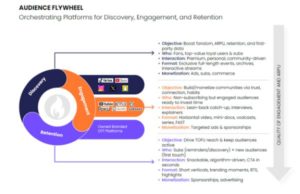The combination of virtual reality and artificial intelligence will be “mind blowing and profitable,” according to Lorenzo Zanni and Stan Moote.
The cool thing about immersive technology like virtual reality (VR) is that it transforms us into an interactive virtual world (full 360 degrees).

So how does artificial intelligence (AI) fit with VR?
If AI is typically defined as intelligent technology capable of replicating human learning and problem-solving skills, the trick with VR will be for AI to anticipate what the viewer wants to see and prepare as it streams out to their headset.
Gamers are doing this now by starting to incorporate AI alongside canned player action responses. This way when a player does something out of the norm, a new reaction is “dreamed up” by the AI engine.
The trick with VR will be for AI to anticipate what the viewer wants to see and prepare as it streams out to their headset - Why immersive tech need artificial intelligence - IABM Journal Share on X
This adds a whole new dimension to the virtual world and there is no reason why this can’t be used for predicting even simple reactions – such as understanding where the viewer will most likely be looking to assure the appropriate resolution is ready to view even when the viewer’s head moves quickly.
The recent IABM End-User Survey revealed that 10% of end-users have already launched some sort of VR offering.
Some 45% said that they are “likely” or “very likely” to launch a VR video offering in the next two-three years while 45% said that they are “unlikely” or “not at all likely” to do so.
45% said that they are likely or very likely to launch a VR video offering in the next two-three years while 45% said that they are unlikely or not at all likely to do so - Why immersive tech need artificial intelligence - IABM Journal Share on X
While the industry is very excited about this new technology, there are indeed some caveats to make.

Stan Moote
VR technology for content acquisition and production is already available but it is priced at a premium compared to other formats – even UHD. At the final consumer end, awareness of the new technology is not high and headset prices remain steep.
Most importantly, VR technology requires the backing of a clear business model for end-users to consistently invest in it.
In the IABM survey, of the end users that already have a VR offering, 68% “don’t know” how to monetise it or are not planning to. “Advertising” was the most popular monetising choice, but with only 12% of respondents.
This lack of a business model suggests low revenue potential for VR in broadcast and media.
For AI, respondents were asked if they were likely to deploy some sort of AI technology in their organisations in the next two-three years.
Some 5% of respondents said that they have already with 38% saying that they are likely to do so in the next few years. And 57% said that they are “unlikely” or “not at all likely” to adopt AI.
”The adoption of AI goes hand-in-hand with the search for increased operational efficiency.”
Across all end-user organisations, only broadcasters, system integrators and production or post-production companies have already implemented AI technology. It is also clear that larger firms are much more likely to adopt the technology.
Across all end-user organisations, only broadcasters, system integrators and production or post-production companies have already implemented AI technology - Why immersive tech need artificial intelligence - IABM Journal Share on X
AI applications in the broadcast and media industry have been rare so far with only a few suppliers launching anything that included some AI elements during 2016 and 2017.

Lorenzo Zanni
Most of these offerings incorporated machine learning applications within workflows.
Other applications for AI include speech recognition, machine translation and metadata auto-tagging. Equally, it can provide ad sales recommendations for commercial broadcasters, network management efficiency for pay-TV operators and recommendation engines to drive personalised UI experiences for online subscription services: Netflix claims that AI technology saves the company $1bn a year.
The adoption of AI goes hand-in-hand with the search for increased operational efficiency that has driven broadcast and media technology procurement in recent years.
As operational efficiency is so important, it is a surprise that more than half of the respondents to the IABM survey show little interest in AI. Perhaps it is considered too futuristic.
IBM Research has been working on AI since the 1950s, however most people are only aware of the cool stuff IBM’s Watson does – like creating the trailer for the movie Morgan. On a less pretentious level, AI is employed by your email service, updating suggested filters by understanding your personal needs.
A natural consequence of AI adoption is the increased automation of routine tasks by media companies to eradicate internal inefficiencies and better monetise their viewership.
A natural consequence of AI adoption is the increased automation of routine tasks by media companies to eradicate internal inefficiencies & better monetise their viewership - Why immersive tech need artificial intelligence - IABM Journal Share on X
This trend is part of an ongoing transformational process to become a true “media factory”.
Even linear programme schedules can be automatically adjusted based on viewer trends and social media interactions.
The main differences between VR and AI on the business side is that AI has a track record of improving profitability, whereas VR is struggling to find its way (beyond gaming) towards being profitable.
Both are cool technologies that need to find practical uses. Tie them together and our new world using immersive technologies will become both mind blowing and profitable too.
Both VR and AI applications will be found in the IBC Future Zone at IBC2017, and the Future Reality Theatre will present a programme of creative, business and technology sessions to answer some of the questions and look at the opportunities, challenges and implications of these coming technologies.
Lorenzo Zanni is IABM Research Analyst and Stan Moote is IABM Chief Technology Officer









